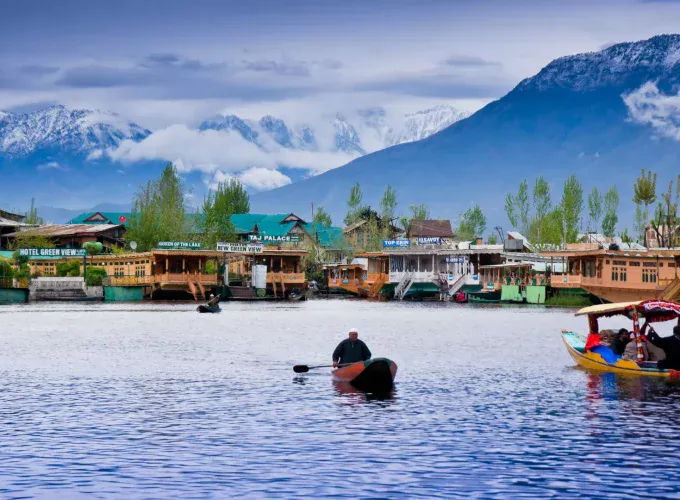Kashmir, often referred to as “Paradise on Earth,” is a region of unparalleled beauty located in the northern part of India. Nestled in the Himalayas, this breathtaking destination offers travelers a unique blend of serene landscapes, rich culture, and warm hospitality. Whether you are a nature enthusiast, an adventure seeker, or a culture buff, Kashmir has something to offer for everyone. This guide will provide you with essential information to plan your perfect trip to Kashmir, covering topics such as currency, language, best time to visit, travel tips, safety, and how to reach this stunning region.
...Currency and Language
The currency used in Kashmir is the Indian Rupee (INR). ATMs are available in major towns and cities, but it is advisable to carry some cash, especially when traveling to remote areas where card payments might not be accepted.
The official languages of Kashmir are Urdu and Kashmiri, but Hindi and English are widely understood and spoken, especially in tourist areas. Knowing a few basic phrases in Hindi or Urdu can enhance your travel experience and help you connect better with the locals.
Best Time to Visit
Kashmir experiences four distinct seasons, each offering a unique charm. The best time to visit depends on the kind of experience you are seeking:
- Spring (March to May): This is arguably the most beautiful time to visit Kashmir. The valley comes alive with blooming flowers, lush greenery, and pleasant weather. The famous Tulip Garden in Srinagar is in full bloom during this period.
- Summer (June to August): Ideal for escaping the scorching heat of the plains, summer in Kashmir offers comfortable temperatures ranging from 15°C to 30°C. It is the perfect time for sightseeing, trekking, and enjoying the houseboat stays on Dal Lake.
- Autumn (September to November): Known for its stunning fall foliage, autumn paints the valley in hues of red, orange, and gold. The weather is cool and pleasant, making it an excellent time for photography and outdoor activities.
- Winter (December to February): If you are a fan of snow, winter is the time to visit. Kashmir transforms into a winter wonderland with snow-clad landscapes and opportunities for winter sports such as skiing and snowboarding in Gulmarg.
How to Reach Kashmir
Kashmir is well-connected by air, road, and rail, making it accessible for travelers from various parts of India and abroad.
- By Air: The Srinagar International Airport (SXR) is the main airport in Kashmir, with regular flights from major Indian cities like Delhi, Mumbai, and Bangalore. International travelers can connect through Delhi or other major airports in India.
- By Road: Kashmir is connected to the rest of India by National Highway 1A, also known as the Srinagar-Leh Highway. Regular bus services operate from Jammu to Srinagar, but for a more comfortable journey, you can hire a taxi or self-drive.
- By Rail: The nearest major railway station is in Jammu (Jammu Tawi), which is well-connected to major cities across India. From Jammu, you can take a taxi or bus to Srinagar, which is approximately 8 hours away.
Top Tourist Attractions
- Srinagar: The summer capital of Jammu and Kashmir, Srinagar is famous for its beautiful gardens, houseboats, and the iconic Dal Lake. Don’t miss the Mughal Gardens, Shankaracharya Temple, and the bustling local markets.
- Gulmarg: Known as the “Meadow of Flowers,” Gulmarg is a popular destination for skiing, trekking, and the Gulmarg Gondola, one of the highest cable cars in the world.
- Pahalgam: This picturesque town is the starting point for the Amarnath Yatra and offers stunning views, lush meadows, and opportunities for adventure sports like river rafting.
- Sonamarg: Meaning “Meadow of Gold,” Sonamarg is known for its pristine beauty, glaciers, and trekking routes. It’s a great place for nature lovers and adventure enthusiasts.
- Leh-Ladakh: Though technically a separate region, a visit to Kashmir is often combined with a trip to the surreal landscapes of Leh and Ladakh, known for their monasteries, high-altitude lakes, and unique culture.
Travel Tips
- Accommodation: Kashmir offers a range of accommodation options from luxury hotels and houseboats to budget guesthouses and homestays. Booking in advance is recommended, especially during peak tourist seasons.
- Clothing: Pack according to the season. Lightweight clothes for summer, layered clothing for spring and autumn, and heavy woolens for winter are essential. Don’t forget to carry comfortable walking shoes.
- Local Cuisine: Savor the local Kashmiri cuisine which includes dishes like Rogan Josh, Yakhni, and Wazwan. Don’t miss the traditional Kahwa (Kashmiri tea) and the variety of breads like Sheermal and Bakarkhani.
- Permits: If you plan to visit certain restricted areas or the border regions, you may need special permits. Ensure to check the requirements in advance and carry the necessary documents.
Safety
Kashmir is generally safe for tourists, but it is always wise to stay updated on the current situation. Follow these safety tips for a hassle-free trip:
- Stay Informed: Keep an eye on the local news and travel advisories from your embassy or consulate.
- Local Guidance: Follow the advice of local authorities and your hotel staff, especially regarding travel to remote areas.
- Respect Local Customs: Kashmir is a culturally rich and conservative region. Dress modestly and respect local customs and traditions.
- Travel Insurance: It’s advisable to have comprehensive travel insurance that covers medical emergencies, trip cancellations, and other unforeseen events.
Kashmir is a destination that promises to leave you spellbound with its natural beauty, rich culture, and warm hospitality. From the tranquil Dal Lake in Srinagar to the snow-capped peaks of Gulmarg, every corner of this region has a story to tell and a sight to behold. Whether you are planning a family vacation, a romantic getaway, or an adventure trip, Kashmir will captivate your heart and soul, leaving you with memories to cherish for a lifetime.

